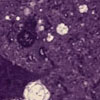
Transmissible Spongiform Encephalopathies (TSEs) are a group of rare progressive neurodegenerative diseases that occur in both humans and animals. The cause of TSEs is believed to be prions, or pathogenic agents that are transmissible and which induce abnormal folding of specific normal cellular proteins (called prion proteins) found in the brain. The abnormal folding induced by the prions leads to brain damage and characteristic symptoms of the disease.
Human TSEs (Prion Diseases)
- Creutzfeldt-Jakob Disease (CJD) is the prototypical human TSE. It is rare, occurring at a rate of one per million worldwide. Primary symptoms of CJD are dementia, followed by rapid mental deterioration. Other symptoms include myoclonus (irregular, involuntary contraction of a muscle), rigidity, nystagmus (rapid, involuntary oscillation of the eyeballs), tremors and visual deficits.
CJD is not contagious person to person, although cases have arisen from various types of tissue transplants and from human growth hormone injections. Hospital guidelines have been developed to avoid those types of transmission.
A new variant of CJD was detected in 1995, now referred to as vCJD.
- Variant Creutzfeld-Jakob Disease (vCJD): There are strong indications that the same agent responsible for BSE ("mad cow disease") outbreaks in cattle is also responsible for vCJD incidences in humans. Both disorders are fatal brain diseases with unusually long incubation periods and are caused by an unconventional transmissible agent. Humans may develop vCJD after eating infected products from cattle with mad cow disease.
Symptoms may include pain or paresthesias (a sensation of prickling, tingling or creeping on the skin), psychosis, depression and anxiety.
Clinical differences between vCJD and CJD include the following: In vCJD, psychological disorders and sensory deficits are typically more pronounced when the disease is first detected than they are with CJD. 99% of CJD victims are 35 or older, while vCJD victims are younger, with a median age of 27.5. Patients with vCJD have a relatively longer duration of illness (median of 14 months as opposed to 4.5 months); additionally, vCJD is strongly linked to exposure, probably through food, to BSE.
Finally, vCJD patients tend to develop amyloid plaques in the brain, while CJD patients do not.
Since the incubation period for vCJD is unknown, possible cases of vCJD in the next few years range from hundreds to tens of thousands.
Animal TSEs (Prion Diseases)
- Chronic wasting disease (CWD) primarily affects deer, but has also been diagnosed in elk. The animals become listless, emaciated, polyuric (have an excessive secretion of urine), polydipsic (are excessively thirsty), and they also drool excessively.
Deer affected by the disease were originally thought to be suffering from a nutritional deficiency, but in 1978 lesions were discovered in the brain like those seen in TSE. So far CWD has been identified in free roaming deer and elk in Wyoming and Colorado, as well as in captive, farmed herds of elk in Nebraska, South Dakota and Oklahoma. Surveillance systems have been established to monitor CWD in captive and hunted deer and elk.
- Bovine spongiform encephalopathy (BSE, more commonly known as "mad cow disease") was first identified in 1986 by British veterinarians. Affected animals exhibit nervousness, heightened senses, weight loss and diminished milk production. As the disease progresses, the animals have difficulty walking and holding up their heads. By 1992 nearly 1,000 per week cases were reported in Britain.
Since then, the United States has maintained a BSE surveillance system on both the state and federal levels. There is a strict enforcement of import restrictions on ruminants (animals which are characterized by chewing again that which has already been swallowed) and ruminant products from any country where BSE exists, and a domestic FDA ban on animal-derived feeds.
More Information
Additional Resources
Contact
For more information contact:
- Your local health office, or call our Health Info Hotline at 1-866-HLTHY4U (1-866-458-4948)

